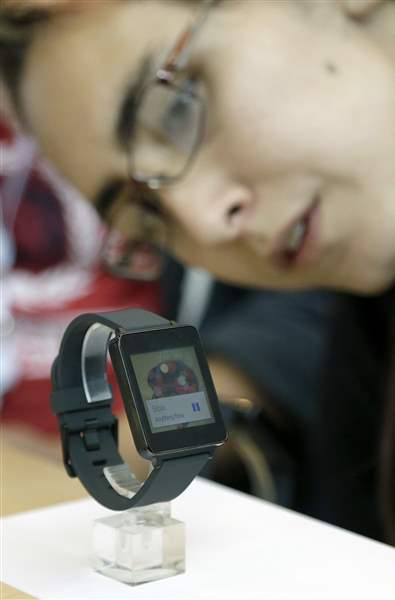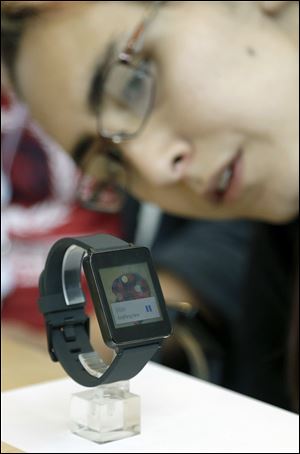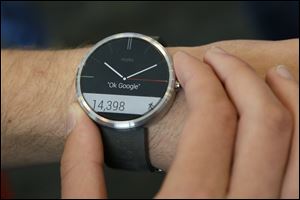
Android simplifies smart-watch technology
Software should help encourage developers
7/5/2014
A woman looks at the LG G Watch, an Android Wear smart watch, on the demo floor at Google in San Francisco. The smart watch, which will be available soon, still is somewhat limited in what it can do, and even last year’s smart watches do some things that Android Wear software can’t.
ASSOCIATED PRESS

A woman looks at the LG G Watch, an Android Wear smart watch, on the demo floor at Google in San Francisco. The smart watch, which will be available soon, still is somewhat limited in what it can do, and even last year’s smart watches do some things that Android Wear software can’t.
NEW YORK — In its first iteration, Google’s Android Wear software for computerized wristwatches isn’t so much about innovation as it is an effort at simplification.
Available in two smart watches out within the next week, Android Wear is rather limited in what it can do. Even last year’s smart watches do some things that Android Wear can’t.
But the new software should help rein in a marketplace of confusion and encourage app developers to extend smart-watch functionality, the way they have made smart phones even smarter.
In previous watches, each manufacturer modified Android in a different way, so software developers have had to spend a lot of time customizing their apps. It’s typically not worth the bother because no single watch has enough users. To confound the problem, Samsung’s second-generation smart watch, out in April, doesn’t use Android at all, but rather a fledging system called Tizen.
With Android Wear, software developers won’t have to rewrite apps every time a new watch from Samsung, Sony, or another manufacturer comes out. And collectively, there might be enough smart-watch users to lure developers.
Developers should have an easier time with Android Wear than Android phones. Phone manufacturers had customized Android so much that apps sometimes didn’t work. Android on phones felt like dozens of different operating systems. With smart watches, manufacturers will pretty much take the software Google gives them and limit customization to hardware, choices of watch face, and apps that come preinstalled.
The first two watches available to the public are Samsung’s $199 Gear Live and LG’s $229 G Watch. I used both to test Android Wear.
Android Wear requires a companion smart phone running Android 4.3 or later. That covers Kit Kat and the later versions of Jelly Bean, but according to Google’s own stats, only about a quarter of Android devices have either. For a variety of reasons, many recent phones can’t be upgraded. And of course, no iPhones.
The companion phone doesn’t have to be from the same manufacturer as the watch. With both watches, I used Motorola’s Moto G phone from November, Samsung’s Galaxy S III phone from 2012, and LG’s G3, which is coming to the United States this summer.
After getting or updating some free apps on your phone, you must link the watch and the phone wirelessly using Bluetooth.

Most of the interactions with Motorola’s Moto 360, an Android Wear smart watch, are by voice.
Most of your interactions with the watch are by voice, similar to using Google Now on Android phones and Siri on iPhones. You can scroll through a short menu of functions, but it’s primarily there as suggestions and isn’t comprehensive. To activate the voice function, just tap on the watch face or say “OK, Google.” You can ask the watch to set an alarm, check your calendar, or send a reminder.
You can’t use the watch as a speaker phone for calls, the way previous Samsung smart watches allowed. But you can make calls or answer incoming ones. The call still goes through the phone, but that’s not a problem if you have a Bluetooth headset.
You can send texts by dictating a message or using canned ones such as “Yes,” ‘‘No,” or “On my way.” You can’t add your own prewritten response, the way you can on Samsung’s previous watches. Android Wear also lets you send and receive emails and read Facebook notifications. I sent myself a draft of this story and was able to read all of it on the watch. If you prefer using the phone, there’s a button you can tap to have the message automatically open there.
The watches also can keep track of your daily steps, and Samsung’s has a heart rate monitor. These tasks and the clock functions are about all you can do without the phone nearby.
Where Android Wear advances smart-watch technology is in navigation. As long as the phone is nearby, you can get turn-by-turn directions on the watch. While walking down the street, you can look at your wrist and avoid having to constantly pull the phone out of your pocket. Sony’s SmartWatch 2 has a maps app, but it doesn’t work as well as Google’s.
Beyond that, the watch offers the types of notifications you’d get through Google Now on the phone, if you’ve turned that feature on. That includes local weather, birthday reminders, and scores for your favorite sports teams. While jogging to work Tuesday morning, Android Wear even offered nearby bus stops in case I wanted to cheat.
Of course, I can simply pull out my phone for all that. Android Wear is supposed to make your life better by displaying relevant information on your wrist, rather than in your pocket.
But you still need the phone nearby, and the voice recognition feature doesn’t always hear me correctly.
Android Wear isn’t quite there yet as a must-have product, but I can only imagine what it will evolve into in the months and years ahead. It helps that there’s now a unified system that software developers can focus on improving.
To check on your phone’s compatibility, visit this Web site from your device: android.com/wear/check.